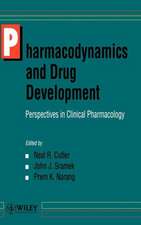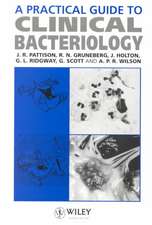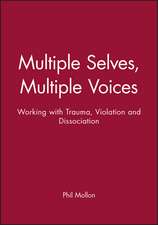Randomised Clinical Trials – Design, Practice & Reporting, 2nd Edition
Autor D Machinen Limba Engleză Paperback – 26 mai 2021
This second edition contains extensively revised material throughout, including new chapters covering designs for repeated measures, non-inferiority, cluster and stepped wedge trials. Other new chapters describe data and safety monitoring, biomarker studies, and feasibility studies. Updated and expanded sections discuss situations where multiple organs, different body locations or competing risks are involved, subgroup analysis, and multiple outcomes. Written by an author team with extensive experience in conducting clinical trials, this book:
- Provides comprehensive coverage of randomised clinical trials, ranging from basic to advanced
- Features several new chapters, updated case studies and examples, and references to changes in regulations
- Explains basic randomised trials, including the parallel two-group controlled trial with a single outcome measure
- Covers paired trial designs and trials with more than two interventions
- Includes a chapter on miscellaneous topics such as adaptive designs, large simple trials, Bayesian methods for very small trials, alpha-spending functions and the predictive probability test
Preț: 650.58 lei
Preț vechi: 684.82 lei
-5% Nou
Puncte Express: 976
Preț estimativ în valută:
124.48€ • 129.99$ • 102.80£
124.48€ • 129.99$ • 102.80£
Carte tipărită la comandă
Livrare economică 15-29 aprilie
Preluare comenzi: 021 569.72.76
Specificații
ISBN-13: 9781119524649
ISBN-10: 1119524644
Pagini: 560
Dimensiuni: 170 x 243 x 32 mm
Greutate: 1 kg
Ediția:2nd Edition
Editura: Wiley
Locul publicării:Chichester, United Kingdom
ISBN-10: 1119524644
Pagini: 560
Dimensiuni: 170 x 243 x 32 mm
Greutate: 1 kg
Ediția:2nd Edition
Editura: Wiley
Locul publicării:Chichester, United Kingdom
Notă biografică
David Machin, Leicester Cancer Research Group, University of Leicester, UK; and Medical Statistics Group, School of Health and Related Research, University of Sheffield, UK. Peter M. Fayers, Institute of Applied Health, University of Aberdeen, UK. Bee Choo Tai, Saw Swee Hock School of Public Health, National University of Singapore, and National University Health System, Singapore; and Yong Loo Lin School of Medicine, National University of Singapore and National University Health System, Singapore.
Cuprins
Preface xiii
Part I Basic Considerations 1
1 Introduction 3
1.1 Introduction 3
1.2 Some completed trials 4
1.3 Choice of design 13
1.4 Practical constraints 18
1.5 Influencing clinical practice 20
1.6 History 20
1.7 How do trials arise? 22
1.8 Ethical considerations 24
1.9 Regulatory requirements 24
1.10 Focus 25
1.11 Further reading 25
2 Design Features 27
2.1 Introduction 27
2.2 The research question 29
2.3 Patient selection 30
2.4 The consent process 32
2.5 Choice of interventions 33
2.6 Choice of design 35
2.7 Assigning the interventions 37
2.8 Making the assessments 38
2.9 Analysis and reporting 38
2.10 Technical details 42
2.11 Guidelines 43
2.12 Further reading 44
3 The Trial Protocol 45
3.1 Introduction 45
3.2 Abstract 47
3.3 Background 49
3.4 Research objectives 49
3.5 Design 52
3.6 Intervention details 53
3.7 Eligibility 56
3.8 Randomisation 58
3.9 Assessment and data collection 61
3.10 Statistical considerations 63
3.11 Ethical issues 66
3.12 Organisational structure 69
3.13 Publication policy 69
3.14 Trial forms 70
3.15 Appendices 71
3.16 Regulatory requirements 72
3.17 Guidelines 74
3.18 Protocols 74
4 Measurement and Data Capture 77
4.1 Introduction 77
4.2 Types of measures 78
4.3 Measures and endpoints 80
4.4 Making the observations 91
4.5 Baseline measures 92
4.6 Data recording 93
4.7 Technical notes 101
4.8 Guidelines 101
5 Randomisation 103
5.1 Introduction 103
5.2 Rationale 104
5.3 Mechanics 104
5.4 Application 113
5.5 Carrying out randomisation 115
5.6 Documentation 119
5.7 Unacceptable methods 120
5.8 Guidelines 120
6 Trial Initiation 121
6.1 Introduction 121
6.2 Trial organisation 122
6.3 Data collection and processing 130
6.4 Internal data monitoring 132
6.5 Ethical and regulatory requirements 133
6.6 Launching the trial 134
6.7 Trial registries 134
6.8 Guidelines 135
7 Trial Conduct and Completion 137
7.1 Introduction 137
7.2 Regular feedback 137
7.3 Publicity 141
7.4 Protocol modifications 142
7.5 Preparing the publication(s) 142
7.6 The next trial? 145
7.7 Protocol 146
8 Basics for Analysis 147
8.1 Introduction 147
8.2 The standard Normal distribution 148
8.3 Confidence intervals 149
8.4 Statistical tests 150
8.5 Examples of analysis 152
8.6 Regression methods 169
8.7 Other issues 179
8.8 Practice 182
8.9 Technical details 183
9 Trial Size 185
9.1 Introduction 185
9.2 Significance level and power 186
9.3 The fundamental equation 188
9.4 Specific situations 190
9.5 Practical considerations 198
9.6 Further topics 203
9.7 Guideline 206
9.8 Software 206
10 Data and Safety Monitoring 209
10.1 Introduction 209
10.2 The DSMB 211
10.3 Early reviews 214
10.4 Interim reviews 219
10.5 Protocols 228
11 Reporting 229
11.1 Introduction 229
11.2 Publication 230
11.3 Responsibilities 233
11.4 Background 235
11.5 Methods 236
11.6 Findings 248
11.7 When things go wrong 258
11.8 Conclusions 259
11.9 Guidelines 260
Part II Adaptions of the Basic Design 263
12 More Than Two Interventions 265
12.1 Introduction 265
12.2 Unstructured comparisons 266
12.3 Comparisons with placebo (or standard) 270
12.4 Dose-response designs 275
12.5 Factorial trials 280
12.6 Complex structure comparisons 289
13 Paired and Matched Designs 293
13.1 Matched-pair trials 293
13.2 Cross-over trials 305
13.3 Split-mouth designs 311
13.4 Guidelines 317
14 Repeated Measures Design 319
14.1 Introduction 319
14.2 Simplified analysis 322
14.3 Regression models 329
14.4 Auto-correlation 331
14.5 Accounting for auto-correlation 334
14.6 The design effect (DE) 338
14.7 Trial size 344
14.8 Practicalities 347
14.9 Reporting 350
14.10 Matched organs receiving the same intervention 354
15 Non-Inferiority and Equivalence Trials 357
15.1 Introduction 357
15.2 Non-inferiority 358
15.3 Analysis 361
15.4 Trial size 366
15.5 Equivalence 370
15.6 Reporting 373
15.7 Practical Issues 373
15.8 Guidelines 373
16 Cluster Designs 375
16.1 Design features 375
16.2 Procedures 376
16.3 Regression models 379
16.4 Intra-class correlation 380
16.5 Trial size 381
16.6 Analysis 386
16.7 Practicalities 388
16.8 Reporting 388
16.9 Further reading 389
17 Stepped Wedge Designs 391
17.1 Introduction 391
17.2 Notation 392
17.3 Basic structure 396
17.4 Randomisation 398
17.5 Cross-sectional design 398
17.6 Closed cohort design 408
17.7 Practicalities 413
Part III Further Topics 415
18 Genomic Targets 417
18.1 Introduction 417
18.2 Predictive markers 418
18.3 Enrichment design 420
18.4 Biomarker-Stratified Designs 422
18.5 Adaptive threshold designs 431
19 Feasibility and Pilot Studies 435
19.1 Introduction 435
19.2 Feasibility studies 436
19.3 External-pilot studies 437
19.4 Considerations across external-pilot and main trial 444
19.5 Internal-pilot studies 445
19.6 Other preliminary studies 447
19.7 Reporting 449
20 Further Topics 451
20.1 Introduction 451
20.2 Adaptive approaches 452
20.3 Large simple trials 461
20.4 Bayesian methods 463
20.5 Interim analyses 467
20.6 Zelen randomised consent designs 472
20.7 Systematic overviews 476
Statistical Tables 483
Glossary 493
References 503
Index 523






















